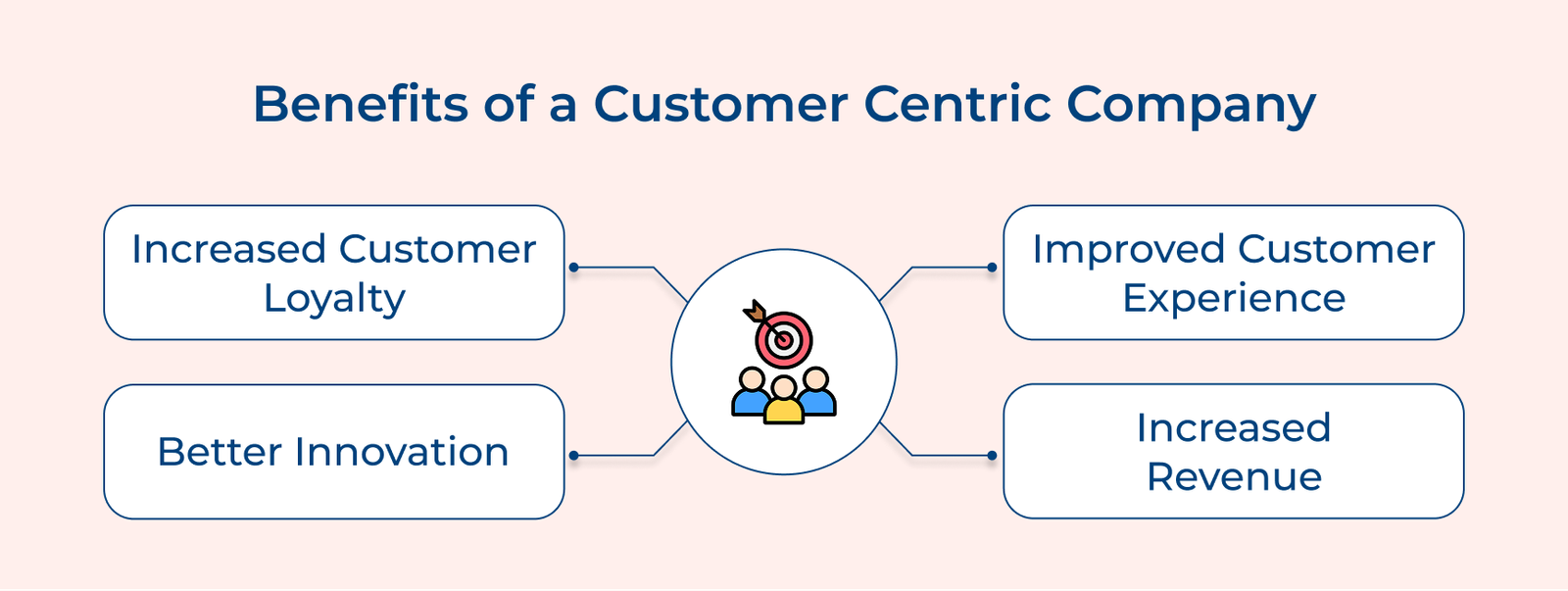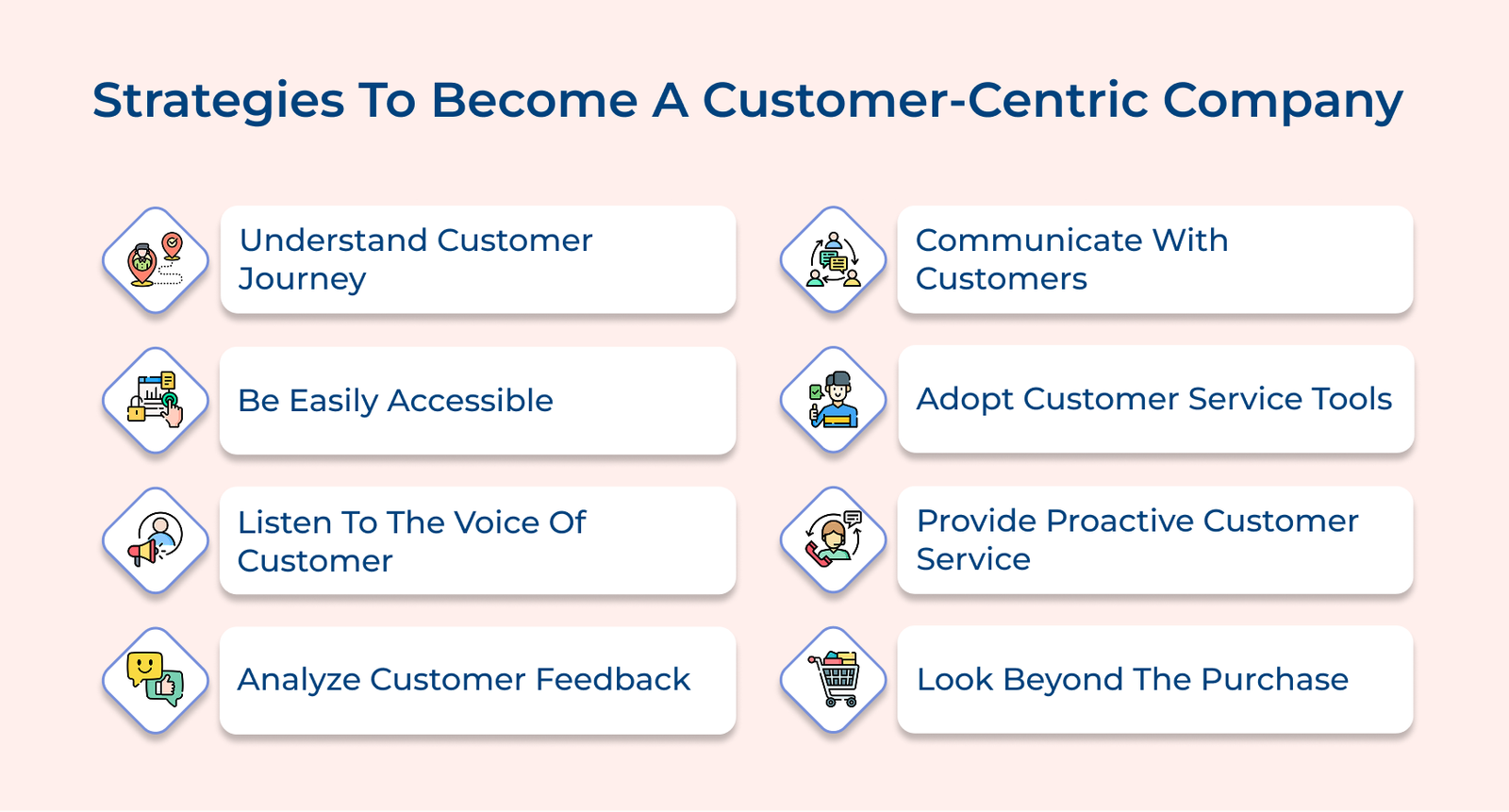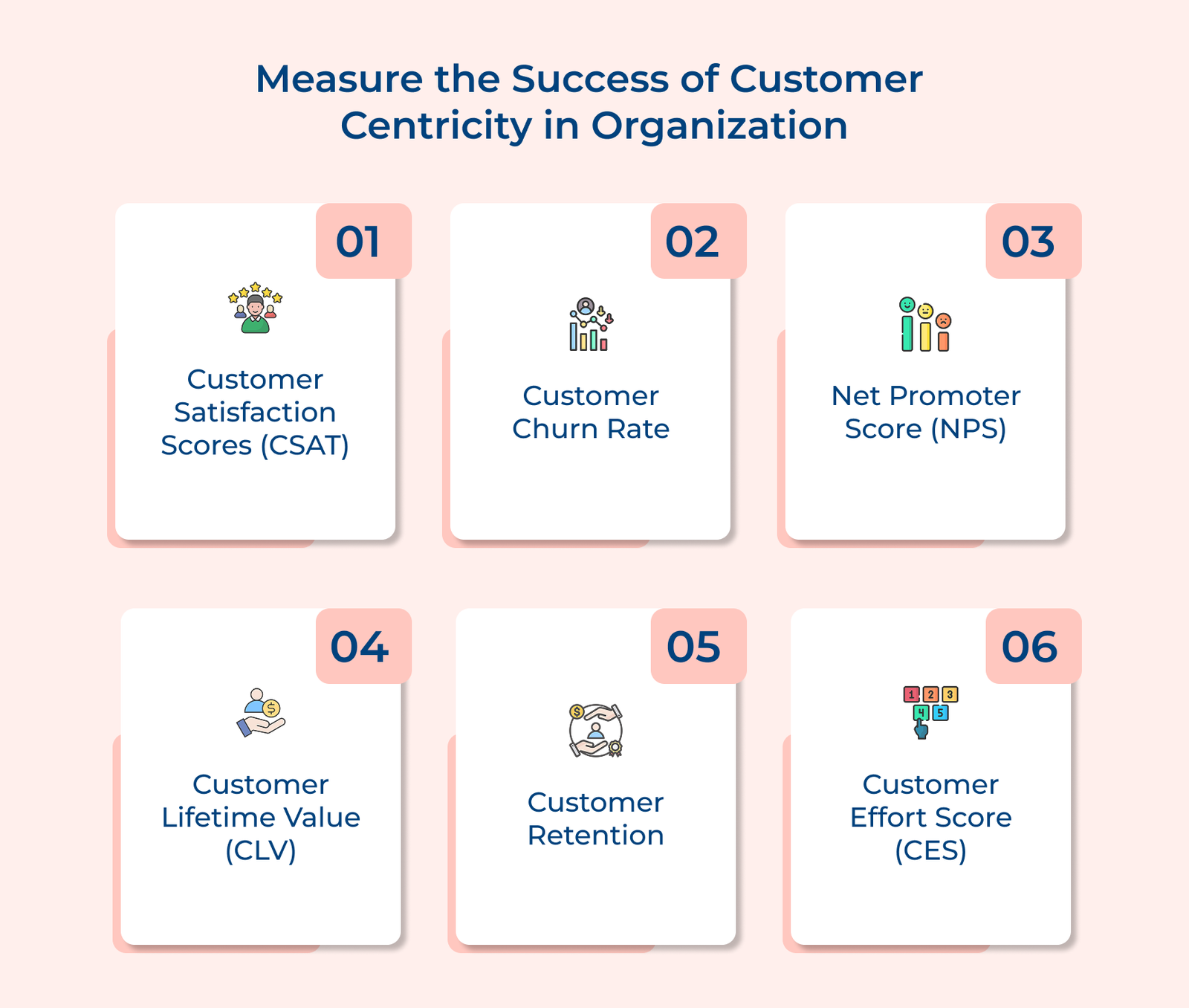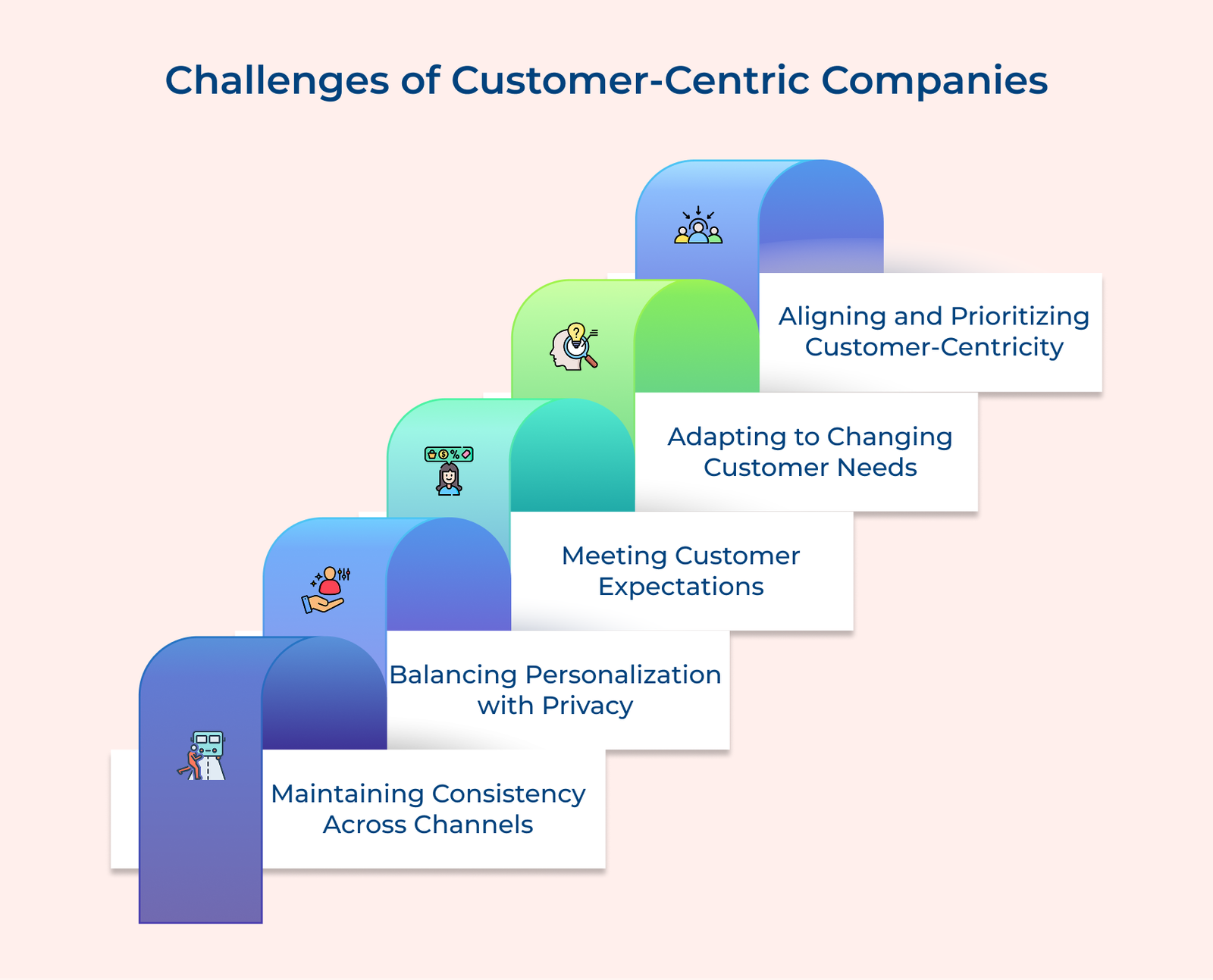1. Understand Customer Journey and Their Needs
Understanding the customer journey and their needs is crucial for becoming a customer-centric company. It involves defining customer personas, which are fictional representations of the target customers based on demographics, behaviors and motivations. Businesses can better tailor their products, services and messaging to their specific needs by creating personas.
Let’s assume that an e-commerce business might map out the customer journey from browsing the website, adding items to the cart, checking out and receiving the order. Pain points could include a confusing checkout process or lengthy delivery times, while opportunities might include personalized product recommendations or seamless returns.
Key Benefits:
- Improved customer satisfaction by understanding the journey and personalized the service according to it.
- Increased customer retention and lifetime value by providing the needs of the customers.
2. Be Easily Accessible
Being easily accessible is a crucial aspect of becoming a customer-centric company. It involves establishing multiple communication channels to cater to diverse customer preferences, such as phone, email, live chat, social media and messaging apps. Optimizing the website and mobile experience is equally important.
Customers expect a consistent experience across all touchpoints, whether they interact with a company through its website, mobile app, physical store or customer service. We can take the example of a retail company offering live chat on their website, a dedicated mobile app with personalized offers and the ability to initiate returns seamlessly across channels.
Best practices:
- Regularly updating communication channels based on customer feedback and usage data.
- Providing comprehensive self-service resources, such as FAQs, tutorials and knowledge bases.
- Training customer service representatives to handle inquiries across multiple channels, ensuring consistent and accurate information.
3. Listen to the Voice of the Customer
Becoming a customer-centric company necessitates listening to the voice of the customer. Encouraging customer feedback is paramount, as it provides invaluable insights into their needs, preferences and pain points. Conduct regular customer surveys to gather direct feedback and ensure that these channels are easily accessible.
Monitor social media platforms and online review sites to understand customer’s experiences with the products or services. Analyze the data to identify recurring themes and areas for improvement.
How to leverage customer feedback:
- Establish a dedicated team or department responsible for collecting, analyzing and acting upon customer feedback.
- Implement a closed-loop feedback system, where customers are informed about the changes or improvements made based on their input, enhancing trust and loyalty.
- Regularly share customer insights with all departments, ensuring that the entire organization is aligned with customer needs and can make informed decisions.
4. Respond and Communicate with Customers
Responding and communicating effectively with customers is crucial for becoming a customer-centric company. Develop a comprehensive customer communication strategy that outlines the channels, tone and response times to ensure a seamless experience. A staggering 48% of consumers expect a response to their queries and complaints within 24 hours.
Let’s assume that a customer reaches out to a clothing retailer regarding a delayed order.
The company promptly acknowledges the inquiry, investigates the issue and provides a clear timeline for resolution, offering a discount or complementary item as a gesture of goodwill.
Pro tips:
- Implement a centralized system to track and manage customer interactions, ensuring no inquiry falls through the cracks.
- Train the customer-facing teams on active listening, empathy and effective communication skills to create a positive experience.
- Continuously gather customer feedback and use it to refine the communication strategies, ensuring they align with evolving customer needs.
5. Adopt Customer Service Tools
Adopting customer service tools is a strategic approach to becoming a customer-centric company. Implement a robust customer relationship management (CRM) system to centralize customer data, enabling personalized interactions and tailored solutions. Utilize live chat and chatbot solutions for real-time assistance, providing immediate responses to inquiries.
Leverage self-service portals and knowledge bases to empower customers with access to relevant information, enabling them to find solutions independently. The strategy not only enhances customer satisfaction but also optimizes resource allocation.
Use cases:
- When a customer encounters a technical issue, they often seek quick effective solutions and a self-service portal provides exactly that. It offers access to detailed step-by-step guides, comprehensive tutorials and practical troubleshooting tips.
- A prospective customer has questions about a product. A chatbot can provide quick responses, guiding them through the features and converting the inquiry into a sale.
- A sales representative can access a customer’s history within the CRM system, enabling personalized recommendations and building stronger relationships.
6. Look Beyond the Purchase
Becoming a customer-centric company requires a fundamental shift in mindset, where the focus extends beyond the initial purchase to cultivating long-term relationships with customers. The strategy emphasizes customer lifetime value, recognizing that retaining and nurturing existing customers is more cost-effective than constantly acquiring new ones.
Nurturing customer relationships involves proactive communication, personalized support and a genuine understanding of their evolving needs. Companies can encourage customer advocacy by enhancing trust and providing exceptional experiences.
Use cases:
- Subscription-based services: Companies can reduce churn and ensure long-term revenue streams by prioritizing customer retention.
- Luxury brands: Building lasting relationships with high-net-worth individuals through personalized service and exclusive experiences can lead to repeat purchases.
- B2B companies: Enhancing strong partnerships with clients by understanding their business challenges and providing tailored solutions can result in recurring revenue.
7. Create an Onboarding Process
Creating an effective onboarding process is crucial for companies aiming to become truly customer-centric. A well-designed onboarding plan ensures that customers are properly introduced to the product or service, setting the stage for a seamless and satisfying experience. A comprehensive onboarding plan should encompass clear instructions, interactive tutorials and easily accessible support resources.
Companies can empower them to fully utilize the offerings and maximize the value derived by providing customers with the necessary knowledge. One use case highlighting the importance of onboarding is in the realm of software-as-a-service (SaaS) products. A well-executed onboarding process can significantly reduce churn rates and increase adoption, as customers are guided through the platform’s features effectively.
Pro tips:
- Personalize the onboarding experience based on customer segments and their specific needs.
- Incorporate feedback loops to continuously improve the onboarding process based on customer insights.
- Leverage automation and self-service options to streamline the onboarding process while maintaining a human touch for more complex issues.
How to Measure the Success of Customer Centricity in an Organization
Here are several key metrics that businesses can use to evaluate their customer-centric initiatives:

















